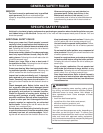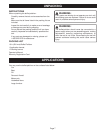
Page 4
SPECIFIC SAFETY RULES
ADDITIONAL SAFETY RULES
Know your power tool. Read operator’s manual
carefully. Learn its applications and limitations, as
well as the specific potential hazards related to this
tool. Following this rule will reduce the risk of electric
shock, fire, or serious injury.
Always wear safety glasses. Everyday eyeglasses
have only impact-resistant lenses; they are NOT
safety glasses. Following this rule will reduce the risk
of serious personal injury.
Protect your lungs. Wear a face or dust mask if
the operation is dusty. Following this rule will reduce
the risk of serious personal injury.
Protect your hearing. Wear hearing protection dur-
ing extended periods of operation. Following this
rule will reduce the risk of serious personal injury.
Inspect tool cords periodically and, if damaged,
have repaired at your nearest Authorized Service
Center. Constantly stay aware of cord location. Fol-
lowing this rule will reduce the risk of electric shock or
fire.
Check damaged parts. Before further use of the
tool, a guard or other part that is damaged should
be carefully checked to determine that it will oper-
ate properly and perform its intended function.
Check for alignment of moving parts, binding of
moving parts, breakage of parts, mounting, and
any other conditions that may affect its operation.
A guard or other part that is damaged should be
properly repaired or replaced by an authorized
service center. Following this rule will reduce the risk
of shock, fire, or serious injury.
Do not abuse cord. Never carry the tool by the cord
or yank it to disconnect it from the receptacle. Keep
cord away from heat, oil, and sharp edges. Follow-
ing this rule will reduce the risk of electric shock or fire.
Keep hands away from work surface. Following this
rule will reduce the risk of serious personal injury.
Use both hands to operate buffer/polisher. Follow-
ing this rule will reduce the risk of serious personal
injury.
Do not use this buffer/polisher as a component of
other products.Following this rule will reduce the risk
of serious personal injury.
Inspect for rough surfaces, protrusions and snags
on work surface before using the buffer/polisher.
Following this rule will reduce the risk of serious per-
sonal injury.
Drugs, alcohol, medication. Do not operate tool
while under the influence of drugs, alcohol, or any
medication. Following this rule will reduce the risk of
electric shock, fire, or serious personal injury.
Save these instructions. Refer to them frequently
and use them to instruct others who may use this
tool. If you loan someone this tool, loan them these
instructions also.
WARNING:
Some dust created by power sanding, sawing, grind-
ing, drilling, and other construction activities contains
chemicals known to cause cancer, birth defects or
other reproductive harm. Some examples of these
chemicals are:
• lead from lead-based paints,
• crystalline silica from bricks and cement
and other masonry products, and
• arsenic and chromium from chemically-
treated lumber.
Your risk from these exposures varies, depending on
how often you do this type of work. To reduce your
exposure to these chemicals: work in a well ventilated
area, and work with approved safety equipment,
such as those dust masks that are specially designed
to filter out microscopic particles.
SERVICE
Tool service must be performed only by qualified
repair personnel. Service or maintenance per-
formed by unqualified personnel could result in a risk
of injury.
When servicing a tool, use only identical re-
placement parts. Follow instructions in the
Maintenance section of this manual. Use of
unauthorized parts or failure to follow Maintenance
Instructions may create a risk of electric shock or
injury.
GENERAL SAFETY RULES
Hold tool by insulated gripping surfaces when performing an operation where the buffer/polisher may con-
tact hidden wiring or its own cord. Contact with a “live” wire will make exposed metal parts of the tool “live” and
shock the operator.














